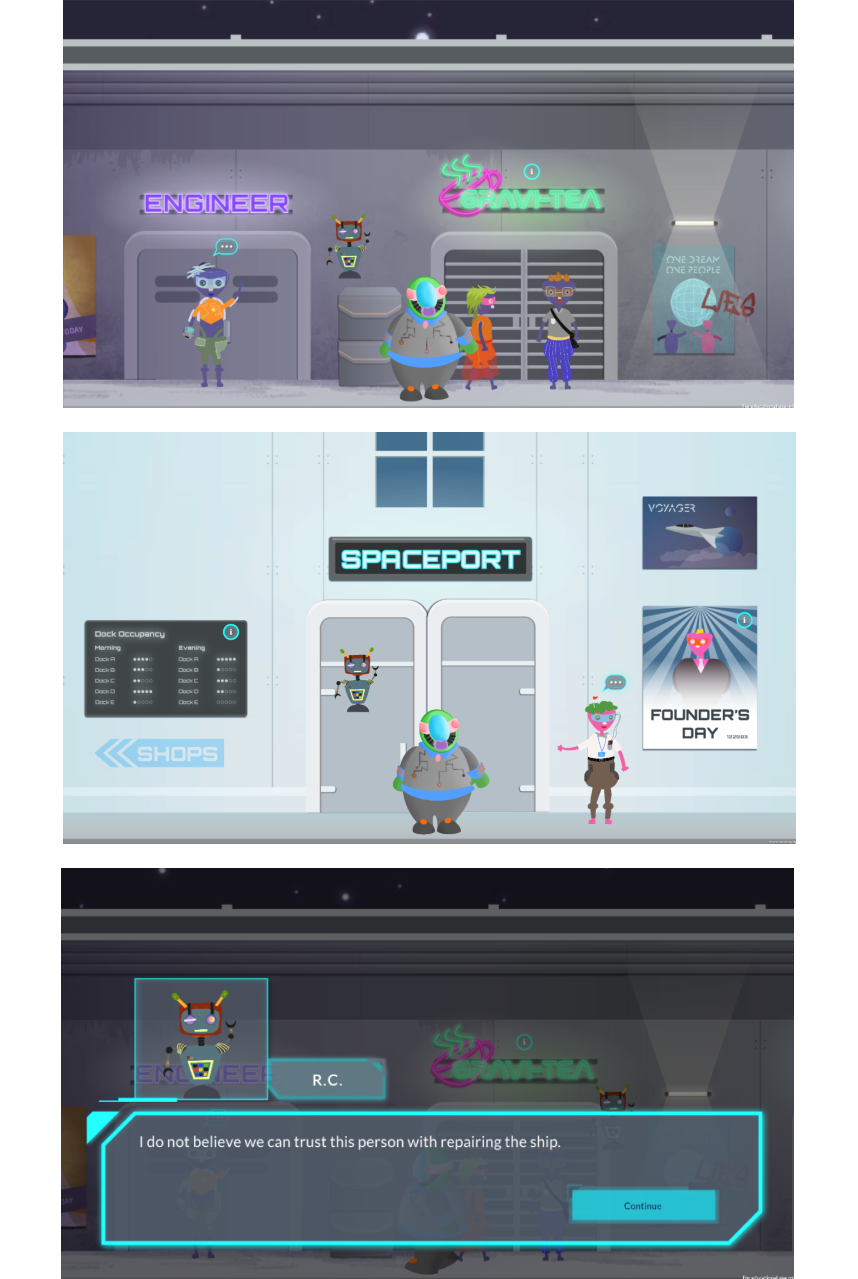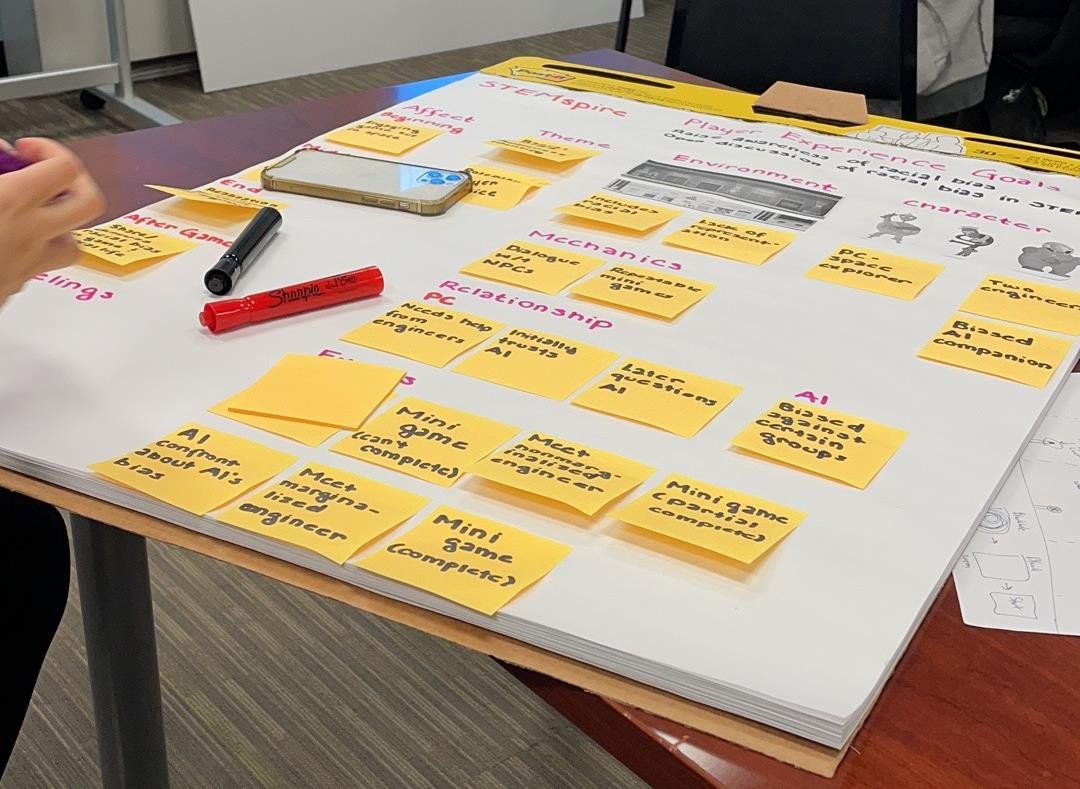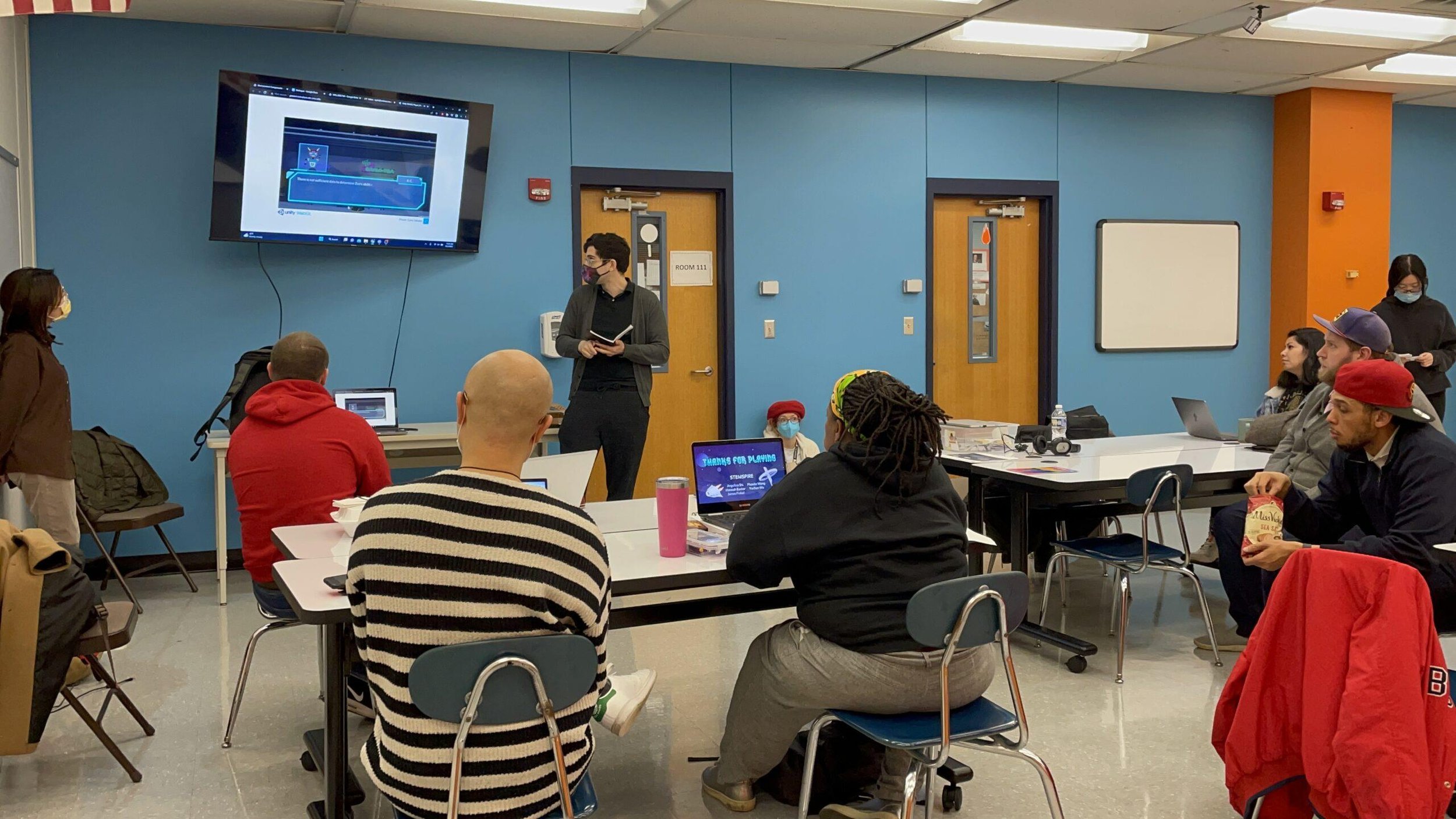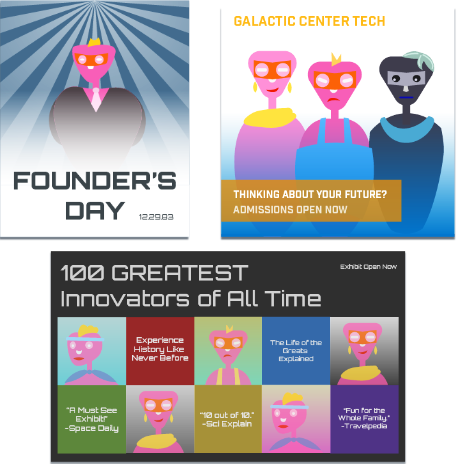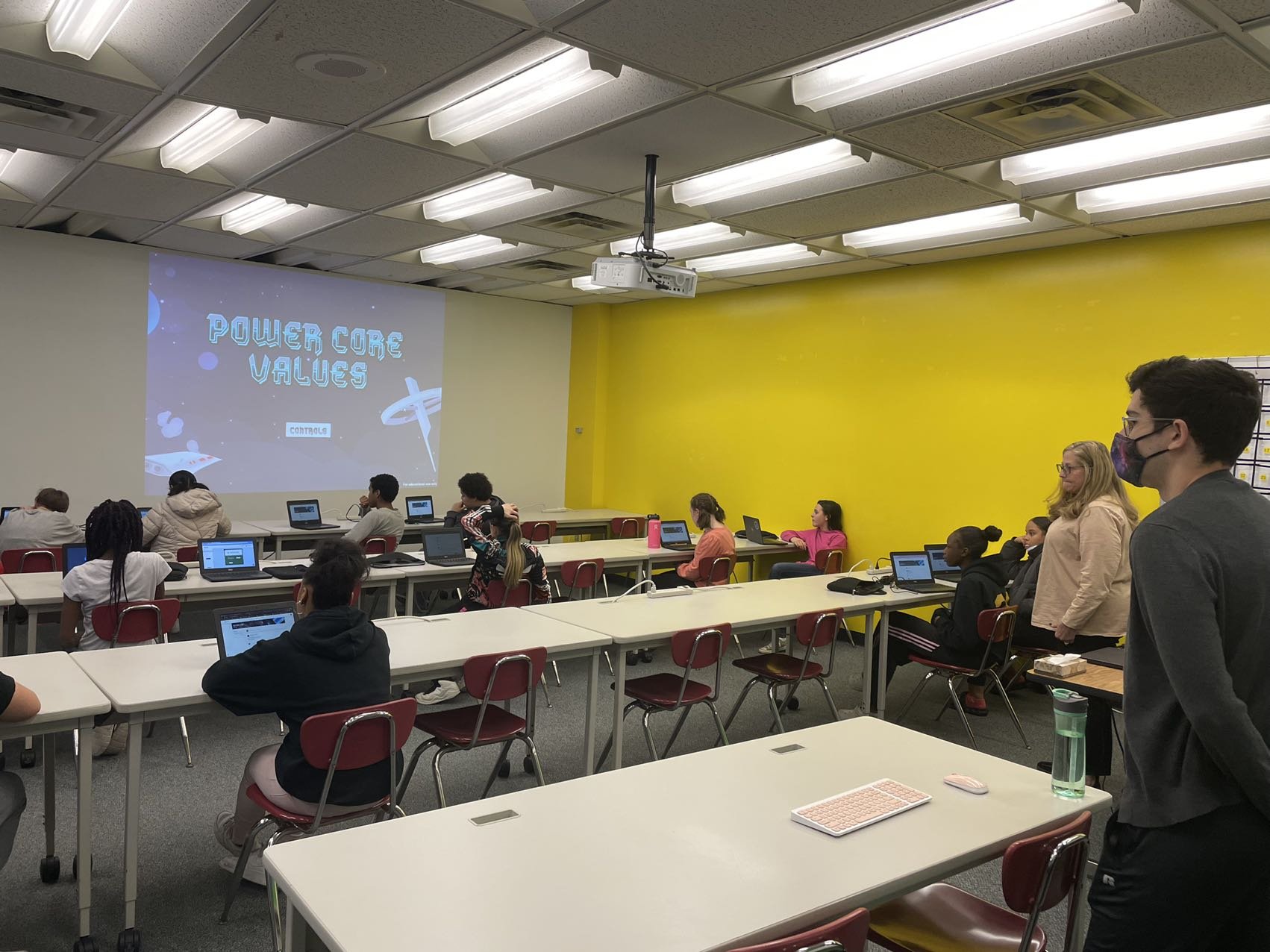
Experience Design
STEMspire
STEMspire is an ETC project team from Carnegie Mellon University of 5, in cooperation with The Collaboratory Against Hate Research and Action Center. The team will be making a web-based game experience together with an after-game workshop, with the goal of educating students on racial bias, especially microaggression. In Spring 2023, the efficacy of our game will be researched by a team from the University of Pittsburgh.
My involvements in this project include designing user interface elements engaging user experience design, designing characters and NPCs, conducting interviews and playtesting as well as sketching stop motion and animations.
Time Period
My Role
Tool Used
10 weeks
UX Designer, 2D Artist, UI Designer
Figma, Procreate, Adobe Illustrator, Adobe PS, Google Suite
Team
James Finkel, Angelina Shi, Hannah Baxter, Phoebe Wang, Yuchan Wu
Client
Instuctor
Michael Christel, Ricardo Washington
Overview
STEMspire is an ETC student project team focused on creating an experience aimed at 8th graders. In cooperation with The Collaboratory Against Hate and John Balash, we will be making a web-based game and a workshop with the goal of educating students on racial bias and arising awareness among our target audiences. Next semester, the efficacy of our game will be researched by a team from the University of Pittsburgh.
Please feel free to visit our project website here.
Background
What is Collaboratory Against Hate?
Who is our target audience?
“ We are researchers from many disciplines collaborating with a common vision and goal: a world free from extremist hate groups.
We study how extremism originates and circulates, how it shapes extremist views and fosters polarization in society, and how it provokes harmful and illegal acts, with a focus on its effects on minoritized and marginalized groups in society. We partner with stakeholders — ranging from victimized communities and advocacy groups to technology companies and policymakers — to better understand underlying issues and design intervention tools. “
8th Grader Middle School Students
Needs & Missions
Arise awareness about racial bias especially microaggression among 8th graders and do no harm
Use proper methodology
Provide for school teachers and let they lead
Suitable art style for target audience
Need to be researched by the Collaboratory Against Hate.
Researched for target audiences and collect pain points. Emphasized their needs and gently covered them to the experience.
Instead of teaching them, creating an experience for them to emerge is better.
Compose a teaching guide for teachers
Conduct surveys and interviews to find their preferences about the art style. Then do playtest and iterate.
Create analytics for researchers.
Clients’ Needs
Our Missions
3 Initial Protypes Narrow Down
Deliverable
Game Experience
Workshop
Teaching Guide
Analytics Report
. Research
What is microaggression?
Facts
Research suggests that students who experience microaggressions have elevated levels of anger, stress, and anxiety.
The students are also likely to exhibit post-traumatic stress symptoms and are more likely to engage in risky behaviors (e.g., drug and alcohol use, sexual activity, involvement in fights) as a means to cope with these symptoms.
Microaggressions can also impair students’ academic performance. Research has found that teachers are more likely to perceive their classes as too difficult for students of color, which is problematic because when students are underestimated by their teachers, they tend to internalize these low expectations and have lower achievement.
Problem & Concerns
Microaggressions are defined as the everyday, subtle, intentional — and oftentimes unintentional — interactions or behaviors that communicate some sort of bias toward marginalized groups
Topics about racial bias are usually sensitive to mention.
People who commit microaggressions might not even be aware of them.
Impact of microaggression is always underestimated compared to discrimination
How might we create an experience to help raise awareness about microaggression educationally among 8th graders and do no harm to them at the same time?
. Ideate
What should we do?
The "micro" in microaggression doesn't mean that these acts can't have big, life-changing impacts. They can, which is all the more reason to address them when you see them.
We should tell them using the experience, this problem:
Exists
Severe
Recognize
Discussed
To Conclude
. Prototype
The main storyline was designed during this time. In the game, you’re a spaceship captain who wants to find help on an unfamiliar planet because your ship was hit by an asteroid. You met a robot companion who follows you everywhere and assists you, which also leads you to neglect the purple skin engineer even it’s qualified. After trying out the pink skin engineer you find out that the robot companion is biased…
. Playtest & Iterate
Playtesting #1
Target Audience:
15 students from age 8-12
Description:
In this period of time we already have a playable prototype with simple art.
Insight:
Students found out the most interesting part is the mini-game, and they didn’t quite get the story
Like to have interactable dialogue.
Like the current art styles.
Playtesting #2
Target Audience:
Middle School teachers and educators
Description:
In this period of time we have a finished experience including a web-based game and a workshop.
Target:
Introduce the game to teachers who may use it AND to outline effective strategies to best utilize what we created.
Insights:
The whole experience is complete and appealing.
To think about how audiences will consider themselves after playing the game, asking: “Where do I see myself in this? “
Think about what is our game aspiring to be in terms of actionable and measurable change/influence.
Iterating
To leverage the user experience when the audience is wandering in the game, I think it is necessary to create some metaphor of racial bias during the game, especially in the background and the dialogue.
Examples of bias in the game
R.C.’s racial bias doesn’t emerge from a vacuum, but is shaped by the information it is exposed to.
All the posters were composed of pink skin people.
. Experience Details
Game - Storyline
You are a spaceship captain, your ship just got hit by an asteroid, your robot companion, R.C., says that we need expert help to repair the ship in the dock.
When you meet the first engineer(Zun) in the Side District, the R.C. won’t let you recruit due to the reason of “not qualified“ even though Zun seems like a good fit.
When you keep wandering you noticed that there are two groups of characters with purple and pink colors, and when you talked with the NPCs, you noticed some info related to racial bias.
According to R.C.’s recommendations, the pink engineer(Nanoi) is not as specialized as advertised and Nanoi recommends Zun instead. R.C. refused this request, you finally confirmed that this robot is biased, so you decided to find Zun by yourself.
Zun is kind enough to accept the request and fixed the ship. And you realized how the actions from R.C. hurts Zun, so you send the robot to fix and apologize to Zun.
We went to Northgate Middle School in local Pittsburgh and experience the workshop with 14 8th Graders as a class, and it went pretty well.
Into the Fold
01
Workshop
02
We will be listing out several situations that happened in the game. For each situation, have the students fold the card of the character they think was hurt; Nanoi, Zun, both, or neither.
Once you have gone through the list, have the students look at their cards. Ask them to smooth the cards out as best they can.
Explain that the creases in the paper are the hurts a character experiences when they are subjected to bias. Smoothing the paper out represents actions we can take to address racial bias in our life and our communities. These actions can help heal some of that hurt, but the hurt doesn’t go away completely. And hurt can mean different things to different people just like the creases are different on everyone’s cards.
Discussion
03
After finishing the game and the workshop, in order to inspire our audiences according to the educators’ suggestions, my teammates and I led an open discussion.
“ At the beginning of the game, we trust that R.C. is always correct, but it turns out that its beliefs are biased, causing harm to other individuals and making things harder for us. While we don’t have a personal robot in our real lives, we all have someone or something we trust that might be feeding us biased information in the same way R.C. does.
Who or what is the R.C. in your life? “
. Comments and Feedbacks
“ Thanks to the Team for choosing this theme, creating this experience, and also bringing this topic up to the table, which is important. “
“ This is a hard topic, even teachers are hard to address, but you guys did a good job. “
Michelle King
Teacher at the Environmental Charter School and publisher of The Learning Instigator.
Zena Ruiz
Community Pollinator, Teaching Artist, Council Member, YMCA




